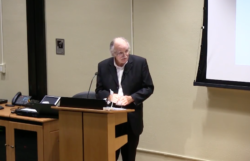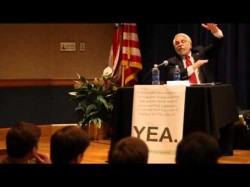The Half-forgotten Debt Crisis
The attention span in Washington DC these days is remarkably short, and multi-tasking is something at which Congress seems particularly inept. So right now the focus there is overwhelming on just one thing, scandals – some genuine, some imagined, all minor – while the real business of the American people goes largely unexamined. The sufferings of the homeless and the foreclosed[1] find no echo there. The fate of the long-term unemployed is likewise ignored;[2] and if real issues surface at all, they do so only occasionally, invariably framed in the old and stale conversation about the size of the federal debt.
So at the end of April, Erskine Bowles and Alan Simpson pitched their “grand bargain” again to readers of The Washington Post.[3] Phil Gramm and Steve McMillin told the readers of The Wall Street Journal last Wednesday that “the debt problem hasn’t vanished.”[4] Most significant of all, the House Appropriations Committee, firmly under Republican control, voted last Tuesday for a second round of spending reductions to begin in October: big reductions in spending on labor, health and education programs in order to free up an increase of $28 billion on defense.[5] It would appear, therefore, that the fight over the size and sources of federal debt has not gone away. It is simply on hold: ready for reactivation when the debt ceiling looms again in the fall. Paul Ryan is on record: “the debt limit is the backstop….we need to get a down-payment on the debt; we need entitlement reform.”[6]
So we have been warned. The old fight will be back sooner than we know. The task therefore is to prepare for it now. The question is how.
One way is to go back, and re-educate ourselves on the complexities of debt in the modern American economy. There is a primer on my website that might help you;[7] and if that is not to your taste, Robert Samuelson has recently provided another,[8] and Jeff Spross a third.[9]
The other way is to go forward, saying at least the following.
· The federal budget deficit is now falling, and will continue to fall to 2015: so that in a genuine sense, the immediate problem is largely solving itself. Paul Krugman is a reliable guide here: “it’s true that right now we have a large federal budget deficit. But that deficit is mainly the result of a depressed economy – and you’re actually supposed to run deficits in a depressed economy to help support overall demand.”[10] In May, the Congressional Budget Office cut the projected deficit for fiscal year 2013 to just $642 billion (4% of GDP), its lowest level since 2008, and has the deficit down to 2.1% of GDP by 2013. 2.1% of GDP is an entirely sustainable level of federal deficit – the product of increasing tax revenues, sequestration cuts, and repayments to the Treasury by Fannie Mae and Freddie Mac. This rate of debt-shrinkage is significantly faster than policy-makers and commentators previously anticipated.[11] Indeed the Treasury expects to repay $35 billion of debt in the second quarter of 2013 – something that has not happened since 2007[12] – taking the heat out of the political battle over the deficit level, at least for now. What heat remains is, in that sense, politically inserted rather than economically dictated.[13] The CBO think that the deficit will rise again in 2016 as baby-boomers tap into Social Security and Medicare. so this problem may reappear; but long-term forecasts are invariably adjusted later, so any immediate major structural change predicated on them is likely to be premature. The best rule of thumb here seems to be, let’s wait and see.
· Other debt problems are not solving themselves, and they should be the focus of any debt discussion to come: not federal debt, but personal debt, housing debt, debt caused by unemployment and – most immediately challenging of all – student debt. Student debt in total ($864 billion in federal loans and $150 billion in private loans) now exceeds $1 trillion, at an average debt/student of more than $25,000 (with one in ten American students now owing more than $54,000 in loans).[14] Many of those students and ex-students face the danger, this July, of seeing their interest rates on those debts double to 6.8% unless Congress acts. Debt levels of this scale among Americans in their 20s and 30s are already having an adverse effect on both house and auto sales, acting as a drag on the already weak consumer-demand side of the struggling U.S. economy; and are doing so at a time when the employment prospects of the Class of 2013 are unusually dismal[15] and when wage levels among young college graduates have not risen in a decade. (On the contrary, on average they dropped 7.6% between 2007 and 2012.[16]) And the problem is not one afflicting young Americans alone. It is hitting older Americans as well: “since 2005, debt levels have more than tripled among those aged 50 to 59 and more than quintupled for borrowers 60 and up.” Indeed, according to a recent Federal Reserve Bank of New York study, “nearly 17% of outstanding student loan debt is held by borrowers age 50 or older,” and the number of Americans whose Social Security benefits have been reduced because of this has risen from six in 2000 to 122,056 in 2012.[17] It is private debt of this kind, and not immediate federal deficit, which is the true threat to the long-term stability of the American economy.
· The academic case for cutting federal spending as the best route to economic growth has just been seriously discredited. The conclusion of the paper by Carmen Reinhart and Kenneth Rogoff that is so often cited by advocates of the austerity route to growth – namely that federal debt levels exceeding 90% of GDP invariably trigger economic slow-down or recession – has recently been shown to be methodologically flawed; as has the earlier and equally influential paper by Alesina and Ardagna that argued much the same.[18] The commentary on these inadequacies is now extensive on both sides of the Atlantic, some of it brilliantly reviewed this month by Paul Krugman in The New York Review of Books.[19] This is one academic controversy on which all of us need to get up to speed: partly by reading Krugman; partly by going back to the critical breakthrough paper by Thomas Herndon, Michael Ash and Robert Pollin;[20] and partly by reading all or part of Mark Blyth’s remarkable Austerity[21] (the subject of Krugman’s review) and/or Robert Kuttner’s stirring Debtor’s Prison.[22] There is no need to cut public spending further now. On the contrary, with economic recovery sluggish and unemployment high, the case for a second stimulus package more than trumps the Republican call for a second round of sequestration. Counter-intuitive though it may seem to those trained only in neoclassical economics, there are certain debts in a modern credit-based economy that are quite simply too crucial to the continued health of the entire system ever to be fully paid off.[23]
· The current Republican enthusiasm for further cutting federal spending runs in the face of clear evidence that the recent tax hikes and budget cuts are slowing the economy down, not revving it up. We are heading, as the New York Times editorial put it in April, in the wrong direction.[24] A growth rate now running modestly at 2.5% per year would be close to 4% were it not for the higher payroll taxes imposed in January and the growing impact on overall levels of demand of sequester cuts too blunt to be targeted properly.[25] But for the counterweight of quantitative easing by the Federal Reserve, our sluggish rate of economic recovery would be lower still.[26] The Director of the Congressional Budget Office told Congress in February that a full set of sequester cuts ($1.2 trillion) would cost the U.S. economy 750,000 jobs in 2013 alone: but to no avail. Conservatives there persist in ignoring the parallel warning from a coterie of leading economists that “the fragile recovery is threatened by obsessive concern with cutting deficits.”[27] That the conservatives’ concern is obsessive was clear even this week, in the tortured response of Oklahoma’s senators to their state’s visible need for large-scale federal recovery aid. Instead of just voting the aid through, we had yet another dance around the whole problem of balancing aid here with cuts there.[28] That was truly appalling nonsense in the wake of such a tragedy!
· The austerity route to growth favored by Republicans has been extensively tried in Europe – both by the British acting alone, and by the Germans seeking a collective route out of the Eurozone crisis. Both attempts have failed: so that even mainstream economic institutions like the IMF are now advocating the moderation/abandonment of austerity-driven recovery programs. So too, if you listen carefully, is the Federal Reserve. The U.K. economy is still teetering on the edge of a triple-dip recession, and the Eurozone is now facing its second quarter in recession. Little wonder then that the IMF, making its annual inspection of the U.K. economy this week, should have advised the Chancellor of the Exchequer there to defer his cuts program (they “pose headwinds to growth” that might jeopardize the U.K.’s “tepid” economic recovery[29]) and instead focus on economic stimulus by investing more in social housing, schools and road repairs. The language used by Fed chairmen is always more circumspect than that common in IMF reports, but Ben Bernanke’s message to Congress last week was essentially the same: that “fiscal policy at the federal level,” as he put it, “has become significantly more restrictive.”[30]
As is often the case, the best way to understand what is happening in Washington D.C. is to leave it. The view from London expressed by Martin Wolf, who is arguably the best financial journalist of his generation, is worth reflecting on in full. In January he wrote this.[31]
The US confronts huge challenges, at home and abroad. Its fiscal position is not one of them. This is a highly controversial statement. If one judged by the debate in Washington, one would conclude that the federal government is close to bankruptcy. This view is false. Yes, the US does confront fiscal challenges in the long-term. But these are largely caused by the soaring costs of it inefficient healthcare. Yes, the US is engaged in a fierce debate on fiscal policy. But this is due to philosophical disputes over the role of the state. Yes, the US has been running large fiscal deficits in the short-term. But these are a result of the financial crisis.
Oh for that level of clarity from the Washington press corps. For Martin Wolf is right: the debt problem that will likely return to center-stage in Washington in the fall will not be primarily economically driven. It will be politically motivated. As the House Appropriations Committee proposals make clear, and the Ryan budget earlier demonstrated, Republicans can live quite happily with increases in spending on things they value: primarily spending on defense. But they are equally prepared to use the debt ceiling fight as cover for a serious attack on the already beleaguered American welfare state. They do not favor increased spending on the poor.[32] The way to counter their reactionary politics in the short term is to make the Keynesian case for public spending as a trigger to private sector growth,[33] and the centrist case for infrastructure investment as the key to long-term prosperity.[34] The way to counter them over the longer term is to reinforce those more technical arguments with moral ones: making the progressive case for greater equality, a fairer sharing of the burdens, and a stronger welfare net.[35]
Putting those two sets of arguments together, and making each regularly and clearly, will give us just some chance of solving the debt crisis in the only way it can ultimately be solved: by using the 2014 mid-terms to end Republican control of the House of Representatives.
[3] Erskine Bowles and Alan Simpson, ‘A grand bargain is still possible. Here’s how,” The Washington Post, April 28, 2013: available at http://articles.washingtonpost.com/2013-04-28/opinions/38885283_1_debt-reduction-fiscal-responsibility-and-reform-new-plan
[4] Phil Gramm and Steve McMillin, “The Debt Problem Hasn’t Vanished,” The Wall Street Journal, May 22, 2013: available at http://online.wsj.com/article/SB10001424127887324787004578494864042754582.html
[5] David Rogers, “House panel oks big spending cuts,” Politico, May 21, 2013: available at http://www.politico.com/story/2013/05/sequestration-house-panel-spending-cuts-91695.html?hp=r2
[6] Lori Montgomery and Zachary A. Goldfarb, “As red ink recedes, pressure fades for budget deal,” The Washington Post, May 3, 2013: available at http://articles.washingtonpost.com/2013-05-07/business/39084441_1_debt-limit-committee-chairman-patty-murray-debt-summit
[7] https://www.davidcoates.net/2012/09/22/a-progressive-primer-on-the-issue-of-americas-debt-problem-ten-things-you-really-need-to-know/
[8] Robert J. Samuelson, ‘The true national debt,” The Washington Post, February 24, 2013: available at http://articles.washingtonpost.com/2013-02-24/opinions/37276145_1_national-debt-loan-guarantees-gdp
[9] Jeff Spross, Guess what? The Debt Everyone Is Freaking Out About Does Not Exist, posted on The Huffington Post, February 25, 2013: available at http://www.alternet.org/guess-what-debt-everyone-freaking-out-about-does-not-exist
[10] Paul Krugman, “The Dwindling Deficit,” The New York Times, January 17, 2013: available at http://krugman.blogs.nytimes.com/2013/05/08/the-dwindling-deficit/
[11] Annie Lowrey, ‘U.S. Budget Deficit Shrinks Far Faster Than Expected,” The New York Times, May 14, 2013: available at http://www.nytimes.com/2013/05/15/business/cbo-cuts-2013-deficit-estimate-by-24-percent.html
[12] Robin Harding and Michael Mackenzie, “US expects first cut in debt since 2007,” The Financial Times, April 30, 2013: available at http://www.ft.com/intl/cms/s/0/9594f870-b113-11e2-9f24-00144feabdc0.html#axzz2U7Vsypyz
[13] Damian Paletta, ‘Deficit Is Shrinking Quickly,” The Wall Street Journal, May 14, 2013: available at http://online.wsj.com/article/SB10001424127887324216004578483223631771366.html.
[14] Anne Johnson, Tobin Van Ostern and Abraham White, The Student Debt Crisis, Washington DC: Center for American Progress, October 25, 2012: http://www.americanprogress.org/issues/higher-education/report/2012/10/25/42905/the-student-debt-crisis/
[15] Heidi Shierholz, Natalie Sabadish and Nicholas Finio, The Class of 2013, Washington DC: EPI Briefing Paper #360, April 10, 2013: available at http://www.epi.org/press/class-2013-faces-dim-job-prospects-depressed/
[16] Heidi Shierholz, Wages of young college graduates have failed to grow over the last decade, EPI Economic Snapshot, April 4, 2013: available at http://www.epi.org/publication/snapshot-wages-young-college-graduates-failed-grow/
[17] Fox Business, Facing Student Loan Debt and Retirement, posted at Bankrate.com March 26, 2013: available at http://www.foxbusiness.com/personal-finance/2013/03/26/facing-student-loan-debt-and-retirement/
The prime source was Donghoon Lee, Household Debt and Credit: Student Debt, New York: Federal Reserve Bank of New York, February 28, 2013: available at http://www.newyorkfed.org/newsevents/mediaadvisory/2013/Lee022813.pdf
[18] Jeffrey Frankel, The Flawed Origins of Expansionary Austerity, posted on Project Syndicate, May 20, 2013: available at http://www.project-syndicate.org/commentary/the-case-against-expansionary-austerity-by-jeffrey-frankel
[19] Paul Krugman, “How the Case for Austerity Has Crumbled,” The New York Review of Books, June 6, 2013: available at http://www.nybooks.com/articles/archives/2013/jun/06/how-case-austerity-has-crumbled/
[20] Thomas Herndon, Michael Ash and Robert Pollin, Does High Public Debt Consistently Stifle Economic Growth? A Critique of Reinhart and Rogoff, University of Massachusetts Amherst: Political economy research Institute, April 15, 2013: available at http://www.peri.umass.edu/236/hash/31e2ff374b6377b2ddec04deaa6388b1/publication/566/
[21] http://www.amazon.com/Austerity-History-Dangerous-Mark-Blyth/dp/019982830X/ref=sr_1_1?s=books&ie=UTF8&qid=1369404155&sr=1-1
[22] http://www.amazon.com/Debtors-Prison-Politics-Austerity-Possibility/dp/0307959805/ref=sr_1_1?s=books&ie=UTF8&qid=1369404223&sr=1-1
[23] Robert Kuttner, “The Debt We Shouldn’t Pay,” The New York Review of Books, May 9, 2013: available at http://www.nybooks.com/articles/archives/2013/may/09/debt-we-shouldnt-pay/?pagination=false
[24] The Editorial Board, “Heading the Wrong Way,” The New York Times, April 27, 2013: available at http://www.nytimes.com/2013/04/28/opinion/sunday/the-economy-is-heading-the-wrong-way.html
[25] Nelson Schwartz, ‘U.S. Spending Cuts Seen as Key in Slowing Growth,” The New York Times, May 2, 2013: available at http://www.nytimes.com/2013/05/03/business/economy/government-spending-cuts-contribute-to-slower-growth.html
[26] Jackie Calmes and Jonathan Weissman, “Economists See Deficit Emphasis as Impeding Recovery,” The New York Times, May 8, 2013: available at http://www.nytimes.com/2013/05/09/us/deficit-reduction-is-seen-by-economists-as-impeding-recovery.html?pagewanted=all
[27] Roger Hickey, 350 Economists Warn Sequester Cuts Could Kill Recovery, posted on The Huffington Post, February 26, 2013: available at http://www.huffingtonpost.com/roger-hickey/350-economists-warn-seque_b_2769032.html
[28] E. J. Dionne, ‘Oklahoma needs help, not ideology, after tornado,” The Washington Post, May 22, 2013: available at http://www.washingtonpost.com/opinions/ej-dionne-oklahoma-needs-help-not-ideology-after-moore-tornado/2013/05/22/51b61548-c30c-11e2-8c3b-0b5e9247e8ca_story.html
[29] Heather Stewart, “George Osborne warned by IMF that cuts ‘pose headwinds’ to growth,” The Guardian, May 22, 2013: available at http://www.guardian.co.uk/politics/2013/may/22/george-osborne-imf-cuts-headwinds
[30] Neil Irwin, “Bernanke to Congress: Seriously guys, what are you doing?” The Washington Post, May 22, 2013: available at http://www.washingtonpost.com/blogs/wonkblog/wp/2013/05/22/bernanke-to-congress-seriously-guys-what-are-you-doing/
[31] Martin Wolf, “America’s fiscal policy is not in crisis,” The Financial Times, January 22, 2013: available at http://www.ft.com/intl/cms/s/0/dd2d89f4-63c0-11e2-af8c-00144feab49a.html#axzz2U7Vsypyz
[32] Alyssa Figueroa, Republicans: There’s No Debt Crisis, We Just Want to Screw the Poor, posted on The Huffington Post, March 18, 2013: available at http://www.alternet.org/tea-party-and-right/republicans-theres-no-debt-crisis-we-just-want-screw-poor
[33] http://www.amazon.com/End-This-Depression-Paul-Krugman/dp/0393345084/ref=sr_1_1?s=books&ie=UTF8&qid=1369404852&sr=1-1
[34] Lawrence Summers, “End the damaging obsession with deficit,” The Financial Times, January 21, 2013: available at http://www.ft.com/intl/cms/s/2/ee9d5688-616d-11e2-9545-00144feab49a.html#axzz2U7Vsypyz
Tags: austerity economics, economic growth, federal deficit, Keynesianism, Reinhart & Rogoff, student debt
David Coates holds the Worrell Chair in Anglo-American Studies at Wake Forest University. He is the author of Answering Back: Liberal Responses to Conservative Arguments, New York: Continuum Books, 2010.
He writes here in a personal capacity.






Barry Clendenin says:
Dear David —
I hope the trend of a decreasing annual deficit level continues, helped along by the January 2013 tax increases and the phasedown of current war(s). Unfortunately some long term challenges remain.
The President’s FY 2014 Budget estimated that Medicare and Medicaid spending would increase by 65 percent and 72 percent respectively between 2014 and 2023; net interest costs on the debt would increase from $223 billion in FY 2014 to $763 billion in FY 2023; accumulated deficits are estimated to total $5.3 trillion and gross Federal debt is estimated to increase from over $18.2 trillion to nearly $25.4 trillion. In comparison, the Congressional Budget Office’s (CBO) May 17, 2013 analysis of the President’s FY 2014 Budget estimated accumulated deficits of $5.2 trillion between FY 2014 and 2023, a total of $1.1 trillion below the CBO baseline for the same period.
As David Wessel recently reminded us in his 2012 book, ‘Red Ink: Inside the High-Stakes Politics of the Federal Budget,’ “The public remains strikingly misinformed about the budget.” And on the expectations side, Robert Reischauer, former CBO Director and President Emeritus of the Urban Institute, summarizes a point that some believe lies at the heart of the choppy budget waters before us this spring. Reischauer observed that “from the mid-1930’s to the 1970’s, [or from FDR and the New Deal to the Carter Administration] the government made a set of commitments that led to expectations on the part of the American people about what their government owes them…And they’re totally unprepared to go back to a different world.” (Wessel, Red Ink, pp. 41 and 70)
The 2014 election may help in resolving choices for the path ahead but it seems that in any case the path will be rocky.
Best regards —
Barry